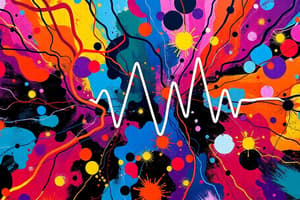Podcast
Questions and Answers
What occurs due to a prolongation of depolarization in a neuron?
What occurs due to a prolongation of depolarization in a neuron?
- Increased repolarization of K+ channels
- Decrease in Ca++ channel activity
- Sustained opening of Ca++ channels (correct)
- Release of serotonin in excess
What factor primarily contributes to synaptic delay?
What factor primarily contributes to synaptic delay?
- Duration of neurotransmitter binding
- Rate of ion exchange
- Number of synapses in the reflex arc (correct)
- Distance between neurons
Which mechanism leads to short term inhibition in synaptic transmission?
Which mechanism leads to short term inhibition in synaptic transmission?
- Inactivation of Ca++ channels (correct)
- Exhaustion of synaptic vesicles
- Gradual inactivation of K+ channels
- Increased release of neurotransmitters
Which of the following describes synaptic plasticity?
Which of the following describes synaptic plasticity?
What is the primary effect of post-tetanic potentiation in a synaptic response?
What is the primary effect of post-tetanic potentiation in a synaptic response?
What characterizes an Excitatory Post Synaptic Potential (EPSP)?
What characterizes an Excitatory Post Synaptic Potential (EPSP)?
What is indicated by a decrease in the rate of discharge of impulses due to repetitive stimulation?
What is indicated by a decrease in the rate of discharge of impulses due to repetitive stimulation?
Which of the following best describes the Grand Post Synaptic Potential (GPSP)?
Which of the following best describes the Grand Post Synaptic Potential (GPSP)?
What primarily leads to sensitization in synaptic transmission?
What primarily leads to sensitization in synaptic transmission?
How does an Inhibitory Post Synaptic Potential (IPSP) affect the post synaptic membrane?
How does an Inhibitory Post Synaptic Potential (IPSP) affect the post synaptic membrane?
During synaptic transmission, what is the consequence of closing K+ channels?
During synaptic transmission, what is the consequence of closing K+ channels?
What is the typical duration of synaptic delay between neurons?
What is the typical duration of synaptic delay between neurons?
What is the role of presynaptic inhibition?
What is the role of presynaptic inhibition?
Which of the following statements about fatigue in synapses is true?
Which of the following statements about fatigue in synapses is true?
What type of summation occurs when multiple EPSPs are received in rapid succession?
What type of summation occurs when multiple EPSPs are received in rapid succession?
Which scenario would most likely result in an action potential being generated?
Which scenario would most likely result in an action potential being generated?
What is the ionic basis for an EPSP?
What is the ionic basis for an EPSP?
What happens during presynaptic facilitation?
What happens during presynaptic facilitation?
Which of the following outcomes occurs if the EPSP is greater than the IPSP but does not reach the firing level?
Which of the following outcomes occurs if the EPSP is greater than the IPSP but does not reach the firing level?
When does an IPSP typically reach its maximum effect?
When does an IPSP typically reach its maximum effect?
Flashcards
EPSP
EPSP
Partial depolarization of the postsynaptic membrane, making the neuron more likely to fire an action potential.
IPSP
IPSP
Partial hyperpolarization of the postsynaptic membrane, making the neuron less likely to fire an action potential.
Temporal Summation
Temporal Summation
Summing of EPSPs or IPSPs occurring close together in time at the same synapse.
Spatial Summation
Spatial Summation
Signup and view all the flashcards
GPSP
GPSP
Signup and view all the flashcards
Presynaptic Inhibition
Presynaptic Inhibition
Signup and view all the flashcards
Presynaptic Facilitation
Presynaptic Facilitation
Signup and view all the flashcards
Synaptic Transmission
Synaptic Transmission
Signup and view all the flashcards
Synaptic Delay
Synaptic Delay
Signup and view all the flashcards
Synaptic Fatigue
Synaptic Fatigue
Signup and view all the flashcards
Synaptic Plasticity
Synaptic Plasticity
Signup and view all the flashcards
Habituation
Habituation
Signup and view all the flashcards
Post-tetanic potentiation
Post-tetanic potentiation
Signup and view all the flashcards
Sensitization
Sensitization
Signup and view all the flashcards
Serotonin and cAMP
Serotonin and cAMP
Signup and view all the flashcards
Study Notes
Synaptic Potentials
-
Excitatory Postsynaptic Potential (EPSP):
- Causes partial depolarization of the postsynaptic membrane.
- Reaches maximum after 1-1.5 milliseconds.
- Lasts 2-5 milliseconds.
- Ionic basis: excitatory neurotransmitter binding to receptors opens ligand-gated Na+ (or Ca++) channels, allowing Na+ (or Ca++) influx, creating a small depolarization.
- Summation is required to reach threshold for an action potential.
- Temporal summation occurs when the presynaptic neuron is stimulated repeatedly in quick succession.
-
Inhibitory Postsynaptic Potential (IPSP):
- Causes partial hyperpolarization of the postsynaptic membrane.
- Reaches maximum after 1.5-2 milliseconds.
- Lasts 3 milliseconds.
- Ionic basis: inhibitory neurotransmitter binding to receptors opens ligand-gated Cl- (or K+) channels, allowing Cl- influx (or K+ efflux), creating a small hyperpolarization, moving the membrane away from the firing level.
- IPSPs can also be produced by closing Na+ or Ca++ channels.
- Summation is required to affect membrane potential.
- Temporal and spatial summation are similar to EPSPs.
-
Grand Postsynaptic Potential (GPSP):
- Sum of all EPSPs and IPSPs occurring at the same time in one postsynaptic neuron.
- Four possible outcomes:
- Balance between facilitation and inhibition: no change to membrane potential.
- Facilitation: EPSP > IPSP, no action potential.
- Action potential: EPSP >> IPSP, membrane reaches firing level.
- Inhibition: IPSP > EPSP, hyperpolarization.
Action Potential vs. Postsynaptic Potential
-
Action Potential:
- All-or-none law.
- Cannot be graded.
- Cannot be summed.
- Propagated.
- Has absolute refractory period.
- Blocked by anesthesia.
- Duration: 1 millisecond.
-
Postsynaptic Potential:
- Does not follow all-or-none law.
- Graded (amplitude varies).
- Can be summed.
- Not propagated.
- No absolute refractory period.
- Not blocked by anesthesia.
- Duration: 20 milliseconds.
Presynaptic Potentials
-
Presynaptic Inhibition:
- Third neuron (inhibitory) releases an inhibitory transmitter.
- Mechanisms:
- Closure of Ca++ channels.
- Opening of K+ or Cl- channels.
- Reduced Ca++ entry into the presynaptic knob, decreasing neurotransmitter release.
- Slow development, lasting minutes to hours.
-
Presynaptic Facilitation:
- Third neuron (excitatory) releases an excitatory transmitter (e.g., serotonin).
- Serotonin/cAMP increases in the presynaptic knob.
- Phosphorylates a protein in K+ channels.
- Closes K+ channels, prolonging depolarization.
- Increased Ca++ influx causing sustained neurotransmitter release.
Synaptic Transmission Characteristics
- Forward Direction (Unidirectional): Impulses travel from presynaptic to postsynaptic neuron.
- Synaptic Delay: Time taken for an impulse to travel across a synapse, typically 0.5 milliseconds.
- Fatigue: Decreased rate of impulse discharge from the postsynaptic neuron due to repetitive stimulation (exhaustion of synaptic vesicles).
Synaptic Plasticity
- Short-Term Inhibition (Habituation): Gradual loss of response to a benign stimulus repeated at intervals (inactivation of Ca2+ channels reducing neurotransmitter release).
- Short-Term Facilitation (Post-tetanic Potentiation): Brief, high-frequency stimulation of a presynaptic neuron; brief, intense stimulation leading to sustained release of neurotransmitter. Ionic basis is accumulation of Ca2+ in the presynaptic neuron, weakening Ca2+ pump.
- Sensitization: Prolonged augmented response of the postsynaptic neuron due to application of a noxious stimulus accompanying a benign stimulus (Pre-synaptic facilitation).
Studying That Suits You
Use AI to generate personalized quizzes and flashcards to suit your learning preferences.



